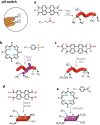Self-assembled π-conjugated chromophores: preparation of one- and two-dimensional nanostructures and their use in photocatalysis
- PMID: 38639760
- PMCID: PMC11097008
- DOI: 10.1039/d4nr00383g
Self-assembled π-conjugated chromophores: preparation of one- and two-dimensional nanostructures and their use in photocatalysis
Abstract
Photocatalytic systems have attracted research interest as a clean approach to generate energy from abundant sunlight. In this context, developing efficient and robust photocatalytic structures is crucial. Recently, self-assembled organic chromophores have entered the stage as alternatives to both molecular systems and (in)organic semiconductors. Nanostructures made of self-assembled π-conjugated dyes offer, on the one hand, molecular customizability to tune their optoelectronic properties and activities and on the other hand, provide benefits from heterogeneous catalysis that include ease of separation, recyclability and improved photophysical properties. In this contribution, we present recent achievements in constructing supramolecular photocatalytic systems made of chromophores for applications in water splitting, H2O2 evolution, CO2 reduction, or environmental remediation. We discuss strategies that can be used to prepare ordered photocatalytic systems with an emphasis on the effect of packing between the dyes and the resulting photocatalytic activity. We further showcase supramolecular strategies that allow interfacing the organic nanostructures with co-catalysts, molecules, polymers, and (in)organic materials. The principles discussed here are the foundation for the utilization of these self-assembled materials in photocatalysis.
Conflict of interest statement
There are no conflicts to declare.
Figures











References
Publication types
LinkOut - more resources
Full Text Sources
Research Materials
Miscellaneous

